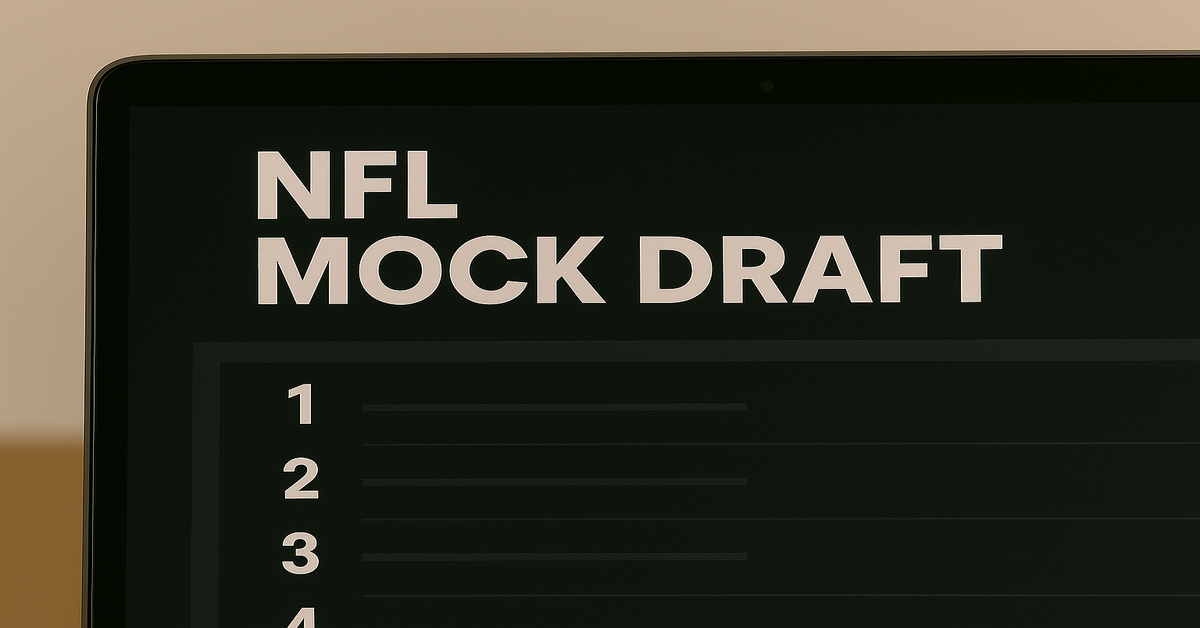NFL Mock Draft: Breakdown of Predictions, Strategy & Team Needs
The NFL Mock Draft is one of the most anticipated events on the professional football calendar. Each year, teams look to add fresh talent to their rosters through the selection process, and fans, analysts, and media outlets engage in speculative exercises known as mock drafts. A mock draft attempts to predict the order and selections of teams based on their needs, draft position, player performances, and organizational philosophies. More than just a projection, a mock draft is a blend of data analysis, scouting reports, team rumors, and educated guesswork.
In this extensive guide, we will explore the essence of an NFL mock draft—its structure, the methodology behind constructing it, the factors teams consider in draft decisions, and the potential implications of various draft choices. Whether you’re a die-hard fan or a curious newcomer, this deep dive will help you understand the complexities behind mock drafting and its real-world impact.
Understanding the NFL Draft Structure
Draft Order Determination
The NFL Draft consists of seven rounds. The order of selection is determined by the teams’ performance in the previous season. The team with the worst record picks first, while the Super Bowl champion picks last in each round. Trades can alter draft positioning, with teams moving up or down based on strategic decisions.
Importance of the First Round
While talent exists throughout all seven rounds, the first round is crucial. Teams often find franchise-changing players in this opening round—quarterbacks, edge rushers, cornerbacks, and offensive tackles typically dominate early selections.
The Art of Mock Drafting
What Is a Mock Draft?
A mock draft is a forecast of draft selections. It serves as a tool for discussion, debate, and analysis. Analysts create versions for various scenarios: team-specific mocks, position-based mocks, or full 32-team first-round predictions. Some even stretch to all seven rounds.
Who Creates Mock Drafts?
Mock drafts are crafted by sports journalists, former players, draft analysts, scouts, and fans. Well-known figures like Mel Kiper Jr., Todd McShay, and Daniel Jeremiah publish highly influential mocks that shape public perception.
Key Elements in Building a Mock Draft
Team Needs Analysis
A foundational step in building a mock draft is understanding what each team lacks. Team needs can be based on the following:
- Recent free agent departures
- Age or performance decline in key positions
- Injuries
- Scheme changes under new coaching staff
Best Player Available vs. Positional Need
Some teams draft the best player available (BPA) regardless of position, while others prioritize filling specific gaps. A great mock draft finds a balance between value and need.
Player Evaluation Metrics
- College production
- Athletic testing (e.g., 40-yard dash, bench press)
- Injury history
- Character and leadership
- NFL Combine and Pro Day performances
Trades and Speculation
Many mock drafts include projected trades. These are speculative, but they help illustrate realistic strategies teams might employ to secure key players.
Position-by-Position Breakdown
Quarterbacks (QB)
Quarterbacks typically dominate the top of the draft. Teams with long-term uncertainty at the position often move up to secure their preferred passer. A great quarterback can transform a franchise.
Wide Receivers (WR)
With offenses becoming more pass-heavy, elite receivers are often selected in the first round. Route-running, hands, separation skills, and speed are key attributes.
Offensive Linemen (OL)
Tackles and guards are the backbone of an offense. Their importance in protecting the quarterback and enabling the run game can’t be overstated.
Edge Rushers (DE/OLB)
In a league where pressuring the quarterback is critical, edge rushers are highly coveted. Athleticism, bend, and hand usage are crucial.
Cornerbacks (CB)
In pass-centric offenses, lockdown corners are vital. Teams look for length, speed, ball skills, and the ability to play man or zone coverage.
Linebackers (LB)
Versatility is key—today’s linebackers must cover tight ends, play the run, and blitz effectively.
Defensive Tackles (DT)
These players are expected to stop the run and collapse the pocket. Explosiveness and strength are major evaluation points.
Team-by-Team Draft Needs Example (Hypothetical)
AFC East
- Buffalo Bills: WR, LB, DT
- Miami Dolphins: OL, RB, Edge
- New England Patriots: QB, WR, CB
- New York Jets: OL, WR, S
NFC West
- San Francisco 49ers: CB, OL, WR
- Los Angeles Rams: Edge, OL, TE
- Seattle Seahawks: QB, DT, CB
- Arizona Cardinals: OL, WR, Edge
Trends and Observations from Past Drafts
Rise of Rookie QBs
Recent years have shown a trend of teams investing early in quarterbacks, with multiple taken in the top 10 picks.
Increasing Value of Versatility
Players who can play multiple roles—hybrid safeties, dual-threat QBs, offensive linemen with positional flexibility—are rising in value.
Data and Analytics in Drafting
Franchises are increasingly using analytics to make draft decisions. Metrics like Relative Athletic Score (RAS) and Expected Points Added (EPA) are incorporated into evaluations.
Mock Draft Formats
One-Round Mock
The most common type, focusing on the top 32 picks. It’s digestible and offers a snapshot of team priorities.
Three-Round Mock
Provides more depth, especially valuable for evaluating rebuilding teams with multiple early-round picks.
Full Seven-Round Mock
The most detailed format. Requires extensive research but offers the most comprehensive picture of team building.
Live or Interactive Mock Drafts
Fan-run mock drafts or simulators (like those by PFF or The Draft Network) allow users to role-play as GM and make picks for their favorite teams.
Impact of the Mock Draft on the NFL Community
Fan Engagement
Mock drafts keep fans engaged during the off-season. They generate debate and anticipation as each version reflects potential futures.
Media Coverage
TV networks and sports websites dedicate entire segments and special events to mock drafts. They help build storylines for players.
Player Branding
Highly ranked prospects gain visibility and endorsement opportunities based on repeated high placements in mock drafts.
Controversies and Criticisms
Accuracy
Even the best mock drafts are often wrong. Teams don’t always make logical picks, and unexpected trades shift the order.
Influence on Public Perception
Mocks can create unrealistic expectations or pressure on young athletes who are ranked higher than they should be.
Over-Saturation
With thousands of mock drafts published, quality can vary widely. Some are clickbait, while others are genuinely well-researched.
Conclusion
NFL mock drafts offer a thrilling, data-driven, and often unpredictable lens into one of football’s most important offseason events. While no mock draft is 100% accurate, the exercise of constructing and analyzing them brings fans, analysts, and franchises closer to understanding the art and science of team building.
Whether it’s predicting a blockbuster trade, identifying a late-round sleeper, or simply debating who your team should pick, mock drafts are a cornerstone of modern NFL culture. They reflect the game’s evolving strategies, player development, and the ever-present hope that the next pick could be the one to change everything.
FAQs
1. What is an NFL mock draft?
An NFL mock draft is a speculative prediction of which players each team will select in the upcoming NFL Draft.
2. Who creates mock drafts?
Mock drafts are created by sports analysts, former players, fans, journalists, and scouting professionals using team needs and player data.
3. How accurate are NFL mock drafts?
Most mock drafts are partially accurate. They capture team needs and potential picks but rarely predict the exact order correctly.
4. Can teams trade picks during the draft?
Yes, teams frequently trade picks during the draft to move up or down depending on their strategic goals.
5. Where can I create my own mock draft?
You can use online tools like Pro Football Focus (PFF), The Draft Network, and ESPN’s draft simulators.
6. Why are mock drafts so popular?
They offer fans and analysts a way to engage with the NFL offseason, analyze team strategies, and debate player talent.





